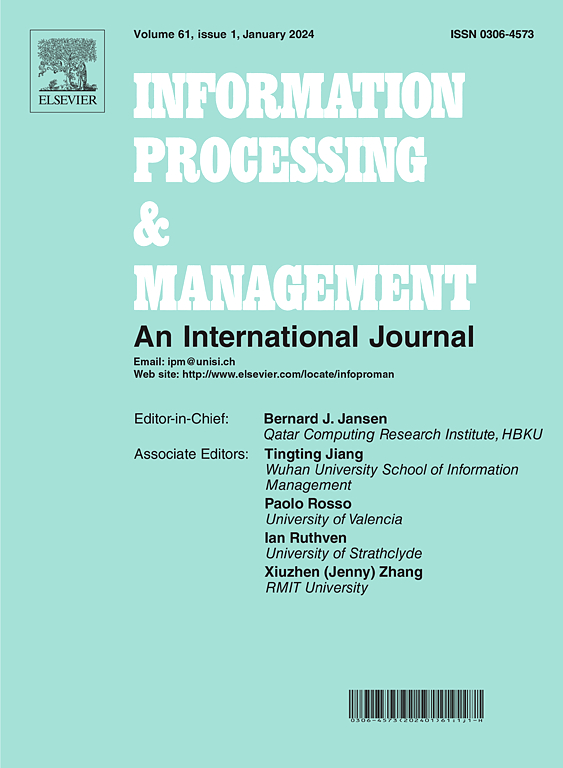使用标签感知双图注意力网络对旅游资源进行分层多标签文本分类
IF 7.4
1区 管理学
Q1 COMPUTER SCIENCE, INFORMATION SYSTEMS
引用次数: 0
摘要
在大数据时代,对在线旅游资源信息进行分类可以促进用户需求与旅游资源的匹配,提高旅游资源整合的效率。然而,该领域的大多数研究都集中在单层单标签的简单分类问题上。本文针对中国旅游资源在线文本信息所呈现的多层次、多标签的复杂分类问题,提出了分层标签感知旅游信息双图注意网络(HLT-DGAT)。该模型将领域知识整合到预先训练好的语言模型中,并利用注意力机制将文本表示转换为基于标签的表示。随后,该模型利用双图注意网络(GAT),其中一个组件捕捉标签层次结构中的纵向信息,另一个组件捕捉横向信息。该模型的性能在两个常用的公共数据集和一个人工编辑的中国旅游资源数据集上得到了验证,该数据集由中国 3A 级以上旅游资源的在线文本概述组成。实验结果表明,HLT-DGAT 在基于阈值和曲线下面积的评价指标上表现出了优势。具体而言,在具有强制叶节点的中国旅游资源数据集上,AU(PRC‾)达到了64.5%,比基线模型的最优相应指标高出3%。此外,消融研究表明:(1)整合领域知识;(2)结合本地信息;(3)考虑同级标签层次中的标签依赖关系;(4)合并动态重构可以提高模型的整体性能。本文章由计算机程序翻译,如有差异,请以英文原文为准。
Hierarchical multi-label text classification of tourism resources using a label-aware dual graph attention network
In the era of big data, classifying online tourism resource information can facilitate the matching of user needs with tourism resources and enhance the efficiency of tourism resource integration. However, most research in this field has concentrated on a simple classification problem with a single level of single labelling. In this paper, a Hierarchical Label-Aware Tourism-Informed Dual Graph Attention Network (HLT-DGAT) is proposed for the complex multi-level and multi-label classification presented by online textual information about Chinese tourism resources. This model integrates domain knowledge into a pre-trained language model and employs attention mechanisms to transform the text representation into the label-based representation. Subsequently, the model utilizes dual Graph Attention Network (GAT), with one component capturing vertical information and the other capturing horizontal information within the label hierarchy. The model's performance is validated on two commonly used public datasets as well as on a manually curated Chinese tourism resource dataset, which consists of online textual overviews of Chinese tourism resources above 3A level. Experimental results indicate that HLT-DGAT demonstrates superiority in threshold-based and area-under-curve evaluation metrics. Specifically, the reaches 64.5 % on the Chinese tourism resource dataset with enforced leaf nodes, which is 3 % higher than the optimal corresponding metric of the baseline model. Furthermore, ablation studies show that (1) integrating domain knowledge, (2) combining local information, (3) considering label dependencies within the same level of label hierarchy, and (4) merging dynamic reconstruction can enhance overall model performance.
求助全文
通过发布文献求助,成功后即可免费获取论文全文。
去求助
来源期刊

Information Processing & Management
工程技术-计算机:信息系统
CiteScore
17.00
自引率
11.60%
发文量
276
审稿时长
39 days
期刊介绍:
Information Processing and Management is dedicated to publishing cutting-edge original research at the convergence of computing and information science. Our scope encompasses theory, methods, and applications across various domains, including advertising, business, health, information science, information technology marketing, and social computing.
We aim to cater to the interests of both primary researchers and practitioners by offering an effective platform for the timely dissemination of advanced and topical issues in this interdisciplinary field. The journal places particular emphasis on original research articles, research survey articles, research method articles, and articles addressing critical applications of research. Join us in advancing knowledge and innovation at the intersection of computing and information science.
 求助内容:
求助内容: 应助结果提醒方式:
应助结果提醒方式:


